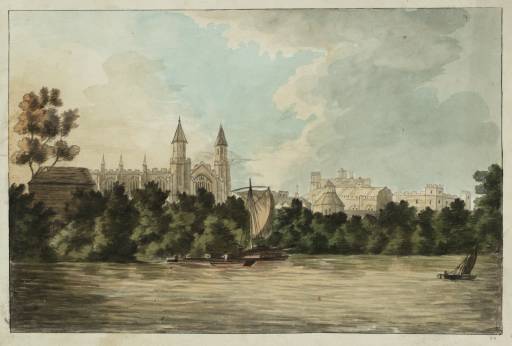This type of paper is known as a ‘blue’ or ‘corrected white’ laid writing paper. This means that a blue colouring agent has been added to a white paper which is naturally slightly yellow in tone, in order to make it appear whiter. This technique was used to counteract any yellowness, or greyness caused by the use of low quality rags in the paper production process. The traditional colouring agent used was a pigment such as smalt (powdered blue glass) but sometimes indigo was used instead. Papers coloured with indigo become yellow over time, because indigo fades more rapidly than any of the other blue colorants used at this time. The sheet was made using a single-faced mould. The image is on the felt side of the sheet.
The watermark is a fleur-de-lys on a crowned shield. This is one of the most common English eighteenth-century watermarks, which makes it impossible to identify the maker of the sheet.
1The image has been worked in ink and watercolour over graphite pencil drawing, which is very detailed for the architecture. The green trees were painted with mixtures of blue and yellow pigments. The pale and grey clouds were created using washes applied to damp paper, while the blue area of the sky is rendered more dramatically through the use of a bright, light blue wash applied to dry paper so that it formed a hard edge against unpainted white paper.
There are three tears along the top edge of the recto, near the right hand side of the page, and another tear in the middle of the left-hand edge of the recto. Prior to conservation in 2009 these had been repaired on the verso using a heavy, cream coloured paper. These repairs were removed and replaced with a lightweight Japanese tissue repair. The tear on the left-hand side of the recto had caused some loss of medium in the foliage of the trees in this area. This loss was repainted using watercolour and paper extract (derived from the paper washing process) to reduce the visual impact of the damage.
Helen Evans
January 2009
Revised by Joyce Townsend
January 2011
How to cite
Helen Evans, 'Technique and Condition', January 2009, revised by Joyce Townsend, January 2011, in Andrew Wilton, ‘Eton College from the River c.1787 by Joseph Mallord William Turner’, catalogue entry, April 2012, in David Blayney Brown (ed.), J.M.W. Turner: Sketchbooks, Drawings and Watercolours, Tate Research Publication, December 2012, https://www.tate.org.uk/art/research-publications/jmw-turner/joseph-mallord-william-turner-eton-college-from-the-river-r1140092, accessed 02 April 2025.

